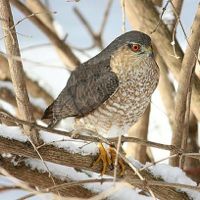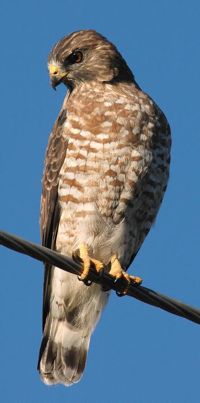By Art Lander Jr.
Special to NKyTribune
Perched in trees along rural roadways, or soaring over pastures and harvested crop fields at the wood’s edge, hawks are more visible during the winter months.
“We have more hawks in the state at this time of year,” said Kate Heyden, raptor biologist for the Kentucky Department of Fish and Wildlife Resources. “Hawks are out hunting and there’s no leaf cover, so they are easier to see in the trees.”
Hawk numbers spike across the state during the winter because of migrant birds from the north — primarily Wisconsin and other Great Lakes states. Kentucky has six species that nest in-state: Sharp-shinned Hawk, Cooper’s Hawk, Red-shouldered Hawk, Broad-winged Hawk, Red-tailed Hawk, and Northern Harrier. The Kentucky Breeding Bird Atlas (1996), by Brainard Palmer-Ball Jr., is a good source of information on Kentucky’s hawks, their abundance and distribution.
To buy online visit the University Press of Kentucky website. Search for The Kentucky Breeding Bird Atlas.
The Sharp-shinned Hawk (Accipiter striatus)
One of two species of hawks in Kentucky limited in abundance and distribution by specific habitat requirements, the Sharp-shinned Hawk relies on pine forests. “They are found in Daniel Boone National Forest, where there are stands of shortleaf pines,” said Heyden.

A small hawk, with a long tail and short, rounded wings, the Sharp-shinned Hawk is an agile, acrobatic flier that speeds through dense woods to surprise its prey — songbirds and mice. Females are considerably larger than males.
Adults are slaty blue-gray above, with narrow, horizontal red-orange bars on the breast. Immature birds are mostly brown, with coarse vertical streaks on white underparts.
Adults and young have broad dark bands across their long tails.
When flying across open areas they have a distinctive flap-and-glide flight style.
During migration, they are often a terror at backyard bird feeders, causing a wave of high-pitched alarm calls among the gathered songbirds.
The Cooper’s Hawk (Accipiter cooperii)
Widely distributed and abundant across Kentucky, the Cooper’s Hawk has been increasing in numbers since the 1980s. Like all raptors of the genus Accipiter it hunts while on the wing, and feeds primarily on Mourning Dove, European Starling and other birds. A favorite attack maneuver is to fly fast and low to the ground, then up and over an obstruction to surprise prey on the other side.
The Cooper’s Hawk is at home in farm country, where there is a mix of forested and open land, but they frequent rural subdivisions and backyards in town. There are high numbers of these hawks in Central Kentucky.
A medium-sized hawk with broad, rounded wings, and a very long rounded tail, the Cooper’s Hawk has a large head, broad shoulders.
Similar in coloration and often confused with the Sharp-Shinned Hawk, adult Cooper’s Hawks are steely blue-gray above with reddish bars on the underparts and thick dark bands on the tail. Juveniles are brown above and crisply streaked with brown on the upper breast.
Broad-winged Hawk (Buteo platypterus)
Of the three hawks that are members of the genus Buteo and nest in Kentucky, the Broad-winged Hawk has the most amazing life history.

This hawk, which lives in upland forests of oak-hickory and mixed pine-hardwoods, nests in Kentucky, yet winters in Central and South America. In one of the greatest spectacles of migration, swirling flocks of Broad-Winged Hawks, known as “kettles,” migrate in masse, in flocks that can contain thousands of circling birds.
Most abundant in the “Hills of the Bluegrass” and Eastern Kentucky, the Broad-winged Hawk is a small, compact raptor with a chunky body and large head. In flight, their broad wings come to a distinct point. The tail is short and square.
Adults have reddish-brown heads, barred underparts, and broad black and white bands on the tail. The pale undersides of the wings are bordered in dark brown.
Juveniles are lighter brown with coarse streaking on the underparts. Broad-winged Hawks hunt small animals from perches underneath the forest canopy.
The Red-shouldered Hawk (Buteo lineatus)
The Red-shouldered Hawk is medium-sized hawk, with broad, rounded wings and proportioned-length tail.
Widely distributed across Kentucky, they are most abundant in the southern third of the state, living in upland and lowland deciduous woodlands along major rivers, streams and wetlands. This is one of most distinctively marked hawks. Adults have dark-and-white checkered wings and reddish barring on the breast. The tail is black with narrow white bands. Immature birds are brown above and white below streaked with brown.
In flight, translucent crescents near the wingtips help to identify the species at a distance. They often glide or soar with their wingtips pushed slightly forward, imparting a distinctive, “reaching” posture.
Never far from water, this forest hawk preys on small mammals, amphibians, and reptiles, usually diving from a perch.
The Red-tailed Hawk (Buteo jamaicensis)
The Red-tailed Hawk, a year-round resident, is perhaps the most conspicuous raptor in Kentucky. This large hawk with very broad, rounded wings and a short, wide tail, is abundant and widely distributed, found in a variety of terrains, but most frequently in farm country.
Adults are brown above and pale below, with a streaked belly and, on the wing underside, a dark bar between shoulder and wrist.
The tail is usually pale below and cinnamon-red above, though in young birds it’s brown and banded.
Red-tailed Hawks soar in wide circles high over a field. In high winds they may face into the wind and hover without flapping, eyes fixed on the ground.
They attack in a slow, controlled dive from a perch, with legs outstretched – much different from a falcon’s stoop. They frequent open country. Look for these hawk along fields and perched on telephones poles, fenceposts, or trees standing alone or along edges of fields.
The Northern Harrier (Circus cyaneus)
The Norther Harrier has very specific habitat requirements that limit its distribution and abundance in Kentucky. This hawk needs open grasslands so populations are restricted to mined areas in West Central and Eastern Kentucky. It is the only hawk species in Kentucky that nests on the ground.
Heyden said the Northern Harrier has benefitted greatly from the intensive grassland management projects on Peabody Wildlife Management Area, in West Central Kentucky, where control burns are used to maintain grassland habitat.
Distinctive in appearance and coloration, the Northern Harrier is a slender, medium-sized raptor with long wings and a long, rounded tail. They have a flat, owl-like face and a small, sharply hooked bill.
Males are gray above and whitish below with black wingtips, a dark trailing edge to the wing, and a black-banded tail. Females and immatures are brown, with black bands on the tail. Northern Harriers fly low over the ground when hunting, weaving back and forth over fields. They eat on the ground, and perch on low trees.
In winter, Northern Harriers migrate southward if the area they nest in receives heavy snow cover.
Hawk Populations in Kentucky
Most of the hawks found in Kentucky are holding their own at this time, and overall, populations have rebounded from contamination by the pesticide DDT (Dichlorodiphenyltrichloroethane) in the 1960s and an outbreak of West Nile Virus (WNV) in the early 2000s.
DDT, a fat-soluble organic compound, was particularly toxic because it concentrated as it moved up the food chain from insects, small birds and rodents, to the raptor. DDT was banned in the U.S. in 1972.
The mosquito species that is most frequently infected with WNV feeds primarily on the blood of birds. Some infected bird hosts ultimately succumb to the virus.
“The Cooper’s Hawk, Red-tailed Hawk and Red-shouldered Hawk are doing very well, their numbers are increasing,” said Heyden. “But the Northern Harrier is a species of concern.”
Birds of prey that nest in Kentucky include falcons, eagles, hawks and owls. Winter the best time view these raptors as populations are highest because of the presence of winter migrants. Keep an eye out for these winged hunters in Kentucky’s woods and fields, and along rivers and lake shores.
Art Lander Jr. is outdoors editor for KyForward, where this story was originally published. He is a native Kentuckian, a graduate of Western Kentucky University and a life-long hunter, angler, gardener and nature enthusiast. He has worked as a newspaper columnist, magazine journalist and author and is a former staff writer for Kentucky Afield Magazine, editor of the annual Kentucky Hunting & Trapping Guide and Kentucky Spring Hunting Guide, and co-writer of the Kentucky Afield Outdoors newspaper column.






















